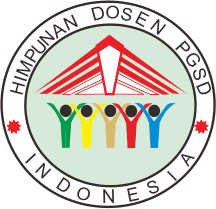Penggunaan media pembelajaran Quizizz untuk meningkatkan motivasi belajar peserta didik dalam memahami teks informatif di Sekolah Dasar
Abstract
Keywords
Full Text:
PDFReferences
[1] Maritsa, A., Hanifah Salsabila, U., Wafiq, M., Rahma Anindya, P., & Azhar Ma’shum, M. (2021). Pengaruh Teknologi dalam Dunia Pendidikan. Al-Mutharahah: Jurnal Penelitian dan Kajian Sosial Keagamaan, 18(2), 91–100. https://doi.org/10.46781/al-mutharahah.v18i2.303.
[2] Saputra, N. P. J., Poerwanti, J. I. S., & Sularmi. (2021). Hubungan Antara Bimbingan Orang Tua dan Motivasi Belajar dengan Hasil Belajar IPS Peserta Didik Sekolah Dasar. Jurnal Pendidikan Dasar, 9(1), 36–41.
[3] Wibawa, E. A., Hakim, A. R., Darmawan, R., & Anggraini, A. (2022). Efektivitas Media Pembelajaran Aplikasi Quizizz Secara Daring terhadap Perkembangan Kognitif Siswa. SAP (Susunan Artikel Pendidikan), 7(2).
[4] Anggraini Sintia, S. (2022). Upaya Guru dalam Meningkatkan Motivasi Belajar Peserta Didik di Sekolah Dasar. Jurnal Basicedu, 6(6), 4855–4861. https://doi.org/https://doi.org/10.31004/basicedu.v6i3.3071.
[5] Wardani, D. K., & Marmoah, S. (2022). Analisis penggunaan aplikasi pembelajaran daring pendukung prestasi belajar siswa sekolah dasar di masa pandemi. Jurnal Pendidikan Indonesia, 10(1), 1–6.
[6] Sodiq, M., Mahfud, H., & Adi, F. P. (2021). Persepsi guru dan peserta didik terhadap penggunaan aplikasi berbasis web “quizizz” sebagai media pembelajaran di sekolah dasar. Didaktika Dwija Indria, 9(5). https://doi.org/10.20961/ddi.v9i6.49324.
[7] Hardiansyah, D. (2023). Penggunaan Quizizz Sebagai Media Pembelajaran Interaktif di Era Digital Guna Meningkatkan Nilai Kognitif pada Peserta didik MAN 3 Medan Kelas Xi. Jurnal Pendidikan dan Media Pembelajaran, 2(2), 9–17. https://doi.org/10.59584/jundikma.v2i2.21.
[8] Slamet, J., & Fatimah, S. (2022). Quizizz Application-Based English Learning Materials Assessment Instrument Development. International Conference on Art, Design, Education and Cultural Studies. http://conference.um.ac.id/index.php/icadecs/article/download/7945/2392.
[9] Hatoliya, W., & Hidayah, S. (2024). The Effectiveness of Quizizz Learning Media in Strengthening Numeric Ability Children. AIP Conference Proceedings, 020077, 1–10.
[10] Hanifah, D. P. (2023). Teori dan Prinsip Pengembangan Media Pembelajaran (D. W. Mulyasari (ed.); 1st ed., Issue August). PRADINA PUSTAKA.
[11] Nurfaizah, Said, A. A., & Latief, N. (2022). Pengaruh Penggunaan Media Pembelajaran Quizizz terhadap Motivasi Belajar Siswa Kelas V. JIKAP PGSD: Jurnal Ilmiah Ilmu Kependidikan, 6(2), 375–382.
[12] Ariyanto, T. P., Harsan, T., & Hadiprasetyo, K. (2021). Peningkatan Motivasi Belajar Siswa Kelas-IV Melalui Aplikasi Quizizz dalam Kegiatan Evaluasi Pembelajaran. Educatif Journal of Education Research, 5(1), 1–13. https://doi.org/10.36654/educatif.v5i1.135.
[13] Azzahra, M. D., & Pramudiani, P. (2022). Pengaruh Quizizz sebagai Media Interaktif terhadap Minat Belajar Siswa pada Pelajaran Matematika Kelas V di Sekolah Dasar. Jurnal Cendekia : Jurnal Pendidikan Matematika, 6(3), 3203–3213. https://doi.org/10.31004/cendekia.v6i3.1604.
[14] Legiman. (2015). Penelitian Tindakan Kelas (PTK). LPMP Yogyakarta, 1(1), 1–15.
[15] Kusmaryono, I., Wijayanti, D., & Maharani, H. R. (2022). Number of Response Options, Reliability, Validity, and Potential Bias in the Use of the Likert Scale Education and Social Science Research: A Literature Review. International Journal of Educational Methodology, 8(4), 625–637. https://doi.org/10.12973/ijem.8.4.625.
[16] Rijali, A. (2019). Analisis Data Kualitatif. Jurnal Alhadharah, 17(33), 81. https://doi.org/10.18592/alhadharah.v17i33.2374.
Refbacks
- There are currently no refbacks.



